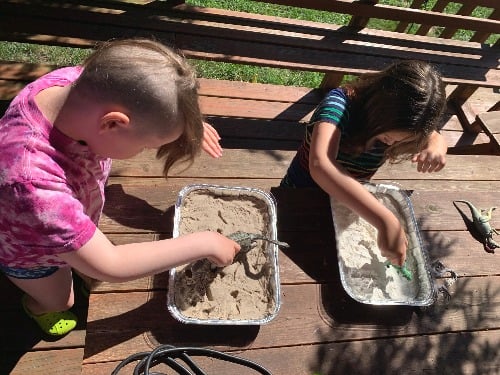Nature Science Activities: Fossils and Dinosaurs
Kids love dinosaurs. There are very few things quite as sure as a child’s love of all things dinosaur. Sometimes, grownups can be intimidated by the topic. Let your little paleontologist guide your explorations!
Don’t let the long names scare you!
Naming a dinosaur comes down to the paleontologist who first discovered the critter. Sometimes, they are named after the place where they were found like Utahraptor. Sometimes they name them after a person like Wendiceratops which was named after a fossil hunter named Wendy Sloboda. Most of the time though, the names can be very long and very intimidating to say. Don’t let that stop you from talking with your dino-obsessed kid. Find out what the name means and use that description instead! Instead of struggling through Thescelosaurus, call it the “marvelous lizard” and “big legged lizard” is so much more descriptive than Barapasaurus! Check out the resources for a great list of dinosaurs, what their names mean, and for the more advanced paleontologists pronunciation guides.
Don’t forget that dinosaurs are animals, too!
If you’re feeling overwhelmed with dinosaurs, focus on the things all animals do! What did they eat? Figuring out if a dinosaur is a meat-eater or a plant-eater is where most young children want to start talking about dinos anyway. How did they stay safe? Look for horns, plates, and spikes. A really fun activity is to build a dinosaur farm or zoo. It might seem silly or overdone (Hello, Jurassic Park?), but your little John Hammonds really need to think about these animals while they’re playing. Do you have enough space to keep your T.rex away from the plant eaters? Deinonychus lived in groups, make sure they’re not living alone! Do we have enough food for our giant Brachiosaurus?
There’s a lot of “We don’t know!” when it comes to dinosaurs. Embrace it!
We can’t see T.rex hunt or Maiasaura take care of her babies. Our knowledge of these extinct animals comes from the relatively small amount of fossils we’ve found and our knowledge of modern animals we can see hunt and take care of their babies. What color was Triceratops? Were dinosaurs nocturnal? What did Pachycephalasaurus use its bumpy head for? As grownups, we don’t always feel comfortable saying “I don’t know,” but with dinosaurs and fossils, it’s something you need to learn to love. Not only do we not have all the answers, sometimes the “answers” change! New discoveries are happening all the time in the field of paleontology. The more we learn, the more we are revising what we thought we knew. This is a great way to help your littles learn that it’s okay to make mistakes - especially if you learn from them!

Dinosaur Trackways
Supplies Needed:
Dinosaur Toys (You can use any toys as long as they make distinct foot prints.)
Clay, dough or tray of sand or flour
Instructions:
- Gather your dinosaurs (or other animals) and make some observations.
Exploration Questions: Which dinosaurs walk on two feet and which walk on four? Which dinosaur has the biggest feet? Which one has the smallest? any have long claws on their toes? Do any of the dinosaurs have tails that touch the ground?
FYI: Dinosaurs likely didn’t drag their tails very often. We actually haven’t found much fossil evidence of tail marks near the footprints!
- Press the feet of your dinosaurs in the sand, clay, or flour. Make more observations!
Exploration Questions: Which dinosaur made the biggest footprints? Do any dinosaurs have front feet that make different prints than their back feet? Can you see imprints of the scales (or fur if you’re using other animals!) omn the footprints? Should be make the really big dinosaurs’ footprints deeper than the smaller, lighter dinosaurs?
- Mix it up and play. Try making prints while one person’s eyes are closed. See if they can match the dinosaur to the footprints. Tell stories with your footprints. Use different dinosaurs and try to tell the story of a great battle or mama taking care of her babies just with footprints.
FYI: A dinsoaur “trackway” is what scientists call fossils that show more than one footprint from the same animal- lIke a set of tracks. For more information on how fossils like trackways are formed and what we can learn from them, check out the resources below.
Fossil and Dinosaur Books:
- Bones, Bones, Dinosaur Bones by Byron Barton
- Dinosaur Farm by Frann Preston-Gannon
- Fossil by Bill Thomson
- If I Had a Raptor by George O’Connor
- Rawr! by Tom H. Doodler
Fossil and Dinosaur Resources:
- Dinosaur Dictionary
https://www.nhm.ac.uk/discover/dino-directory/name/a/gallery.html - Types of Fossils
https://www.dkfindout.com/us/dinosaurs-and-prehistoric-life/fossils/ - Dinosaur Footprints: how do they form and what can they tell us?
https://www.nhm.ac.uk/discover/dinosaur-footprints.html
Additional Resources:
Watch the Fossils & Dinosaurs webinar here:
 Hollie is certified K-8 teacher who has been educating in the informal education field since 2005. She has developed and implemented countless exciting STEAM programs for families, classrooms, and teachers focused on the natural world, the scientific process, and ancient life. Her professional passions are inquiry, whole family learning, experiential learning starting in early childhood, and the intersection of literacy and science instruction.
Hollie is certified K-8 teacher who has been educating in the informal education field since 2005. She has developed and implemented countless exciting STEAM programs for families, classrooms, and teachers focused on the natural world, the scientific process, and ancient life. Her professional passions are inquiry, whole family learning, experiential learning starting in early childhood, and the intersection of literacy and science instruction.
She has recently developed a community-based program that encourages families to use dramatic play to learn science, increase literacy skills, and have fun together for which she received the Drexel University Presidential Award for Civic Engagement. She is most proud of her work on a popular science storytelling program for preschool families and classrooms that combines a book club format with engaging programs, innovative curriculum, and a hysterical puppet storyteller.
